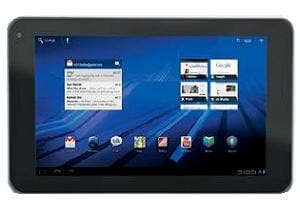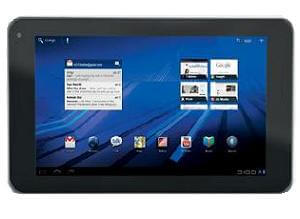G-Slate Tablet To Come With 3D Cameras and Glasses – A Trend Too Far?

Share
T-Mobile recently unveiled the LG G-Slate tablet, a 4G mobile device that will be able to shoot 3D videos in full high definition (1080p). Running on Android 3.0 (Honeycomb), the G-Slate will have plenty of features to grab the public eye: 8.9 inch screen, Tegra2 processor, 2 megapixel front-facing camera for video conferencing, 720p on-device playback, and 1080p HDMI output. Yet it's the two stereoscopic cameras on the back that really set the G-Slate apart. The tablet will be able to shoot and playback 3D video in HD with viewers wearing special glasses. It's not clear if these will be passive (colored/polarized lenses) or active (shuttering). Either way you're going to look a little silly while watching your new 3D video clips, but you may not be alone. Despite poor sales in TVs, 3D technology continues to press forward. Is the G-Slate's venture into 3D videography a sign that T-Mobile has jumped on the wrong bandwagon, or could the new tablet help transform the trend into an industry standard? We'll find out when the G-Slate hits stores in March.
There's little doubt that 3D imagery is going to become an increasing part of our digitally-enhanced world - we've seen it in everything from movies to maps. The use of glasses, however, really limits the technology in many cases, and there are alternatives. True holograms are becoming cheaper to make and easier to print, and groups like the US military are already seeing the benefits of stereoscopic images you can see with your naked eye. Digital displays that rely on parallax could also let you see 3D videos without wearing red and blue shades.
Yet the two-camera and colored glasses approach to 3D videos is the cheapest and most easily deployed use of the technology. You can buy stereoscopic webcams now, and YouTube has plenty of red/blue videos made using these low-end stereoscopic camera systems.
Whether or not 3D video recording increases in popularity, the G-Slate doesn't have to rely on its stereoscopic vision as its only selling point. As T-Mobile's first 4G tablet with Android 3.0, the G-Slate has all the bells and whistles that will make it a much sought-after trophy for techies this spring. The following video from T-Mobile highlights the G-Slate's less controversial features.
Be Part of the Future
Sign up to receive top stories about groundbreaking technologies and visionary thinkers from SingularityHub.


The G-Slate will inspire plenty of purchases, even if the market isn't yet sold on 3D video. One day, maybe soon, the best and cheapest 3D technology won't require glasses, and we'll probably see it takeover as the dominant mode of viewing. At that point the G-Slate will be obsolete. Of course, it's a mobile device, so it'd be obsolete in a year or less anyway.
[image and video credits: T-Mobile]
[sources: T-Mobile Press Release]
Related Articles

This Portable Wind Turbine Is the Size of a Water Bottle and Charges Devices in Under an Hour

Mojo Vision’s New Contact Lens Brings Seamless Augmented Reality a Step Closer
The Weird, the Wacky, the Just Plain Cool: Best of CES 2020
What we’re reading
